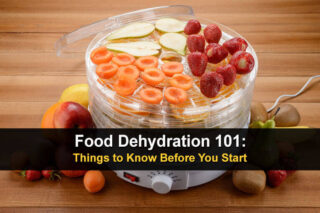Estimated reading time: 6 minutes
Dehydrating foods is one of the oldest methods of preservation, and it was practiced by people around the world long before the advent of electricity. When water is removed from food, the bacteria that cause spoilage cannot grow and multiply, which means that dehydrated foods are shelf stable for extended periods.
Any modern electric food dehydrator is simply a small heating element that warms the air to 90 to 100 degrees, and a fan to ensure good air circulation. If you can mimic these conditions, you can dehydrate food.
There are many ways to gently warm the air and promote good air circulation. Some are simple and a great makeshift way to preserve a small amount of food, and some are more complicated and are more dependable for preserving large amounts of food without depending on the weather.
Want to save this post for later? Click Here to Pin It on Pinterest!
Preparing foods for Dehydration
Food dehydrates best in small pieces with a large surface area. High water fruits should be sliced as thinly as possible and separated so that there's good airflow on all sides.
Sealed berries, like blueberries, will dehydrate best if their skin is punctured to allow moisture to escape. A good way to do this is by quickly blanching the berries in boiling water for 30 seconds to pop them, and then shocking them by placing them in cold water. This pops the berries open and has the added benefit of sterilizing the outside of the berries, which helps prevent spoilage while they're drying.
Fresh herbs and greens are fragile, so they don't need to be sliced. Instead, they can be gently cleaned and hung in small bunches out of direct sunlight.
1. Outdoor Dehydration
If you live in a climate where the air is hot and dry, like much of the American West, dehydrating food is easy without much preparation. Your main concern is to keep bugs off of your food until it's dry enough to store.
Once your food has been prepared for drying, place it outdoors in an area with good air circulation. If available, screen off the area with bug netting, or simply cover the food with a thin cloth, like a handkerchief or sheet. Once the food is dry enough to snap in your hands, it's ready to bring in.
2. Car Dehydration
Your car serves as a mini solar cooker during sunny days, even in mid-winter in the coldest climates. Make sure you crack the windows to allow moist air to escape and help promote a warm, dry environment.
Place the food prepared for dehydration in your car, either in hanging bundles or on trays. Sliced fruits, like apples, dehydrate well strung up on a string which can be strung throughout your car. Just be sure they're not touching anything. A good method to use is to string the string through the windows on both sides and tie something small like a clothespin to each end to keep the string ends stuck outside each of your cracked windows.
If the food is not dry by the end of the first day, be sure to bring it in at night and then put it back out the next day. Moist night air will prevent the food from drying, and negate all your hard work the day before.
3. Fire Dehydration
Lacking a car, a small fire is a great way to create heat and keep bugs away. The smoke and heat keep insects away while your food dries. The convection created by the movement of hot air from the fire also ensures good airflow to carry moisture away.
Build a small fire and keep it smoldering low all day long. String the food up near the fire. Since you're targeting 90-100 degrees, the food shouldn't be too close to the fire. Wherever the food is strung, you should be able to hold your hand there for an extended period. It should feel hot, but not actually burn you.
If the food isn't dry at the end of the day, be sure to bring it in and resume in the morning.
4. Black Tarp Method
You can create heat and natural air movement without a fire or car if you have something large and black that can be spread out on a sunny day. A black tarp or a few black trash bags are great in a pinch.
Spread out the tarp or trash bags on the ground in full sun, and hang the food low over the tarp to maximize heat. You'll need some sort of screen to protect the food from flies and bugs, but be sure to use something as thin as possible to allow most of the sunlight through to hit the black surface.
5. Wood Stove Dehydration
Wood stoves naturally dehydrate the air around them because they draw moist indoor air up and out the chimney along with the smoke. Many people counteract this and try to keep humidity up by placing a kettle or pot of water on the stove when it's running to increase winter humidity. Knowing this, you can take advantage of cool fall days in northern climates to dehydrate your food stores.
Simply place your food on trays or string it up near the woodstove. Keep the woodstove going and you can dehydrate food around the clock without having to pack it up and bring it in at night as you do with outdoor methods.
Unless you really need to run the woodstove hot for heat, it's best to keep it running on a low smolder with the damper mostly closed so that it's keeping the area around it warm and dry, without putting off excessive amounts of heat. If it's already quite cold and you need to run it hot, just move the food back far enough to maintain warmth without overheating it.
6. Solar Dehydrator
If you're planning on using dehydration as a primary method of food preservation, it makes sense to construct a solar dehydrator. There are a lot of different designs out there, but the basic premise is that it has a dark-colored backing which traps heat, while at the same time creating internal air currents as the hot air moves upward through the dehydrator. This air current naturally provides good airflow without a fan and allows for warmth and air movement using physics rather than electricity.
These simple plans from mother earth news are a good place to start. This plan heats air with a black-backed chamber at the bottom, which then naturally rises and causes warm air to circulate around the food in the chamber above.
As you can see, whether you can't afford an electric dehydrator right now or you're trying to use as little electricity as possible, there are plenty of other ways to dehydrate your harvest.
Like this post? Don't forget to Pin It on Pinterest!
You May Also Like:














How thin should the food be sliced?
The thinner the better because if they’re too thick, you may have a hard time dehydrating them.
Hey Heidi,
Nice article and very informational.
Do you have by any chance a tutorial to build a solar dehydrator?
One with step by step will be nice.
Thank you!
Amazing article,
And great way to save money as some food dehydrators use a lot of electricity.
Thanks for this. 🙂
Is it possible to dehydrate milk and eggs without electricity?